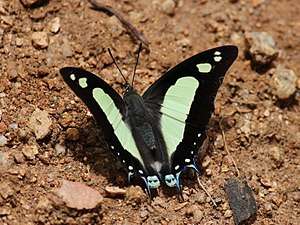Charaxes agrarius
| Anomalous nawab | |
|---|---|
 | |
| Dorsal view | |
 | |
| Ventral view, Karnataka, India | |
| Scientific classification | |
| Kingdom: | Animalia |
| Phylum: | Arthropoda |
| Class: | Insecta |
| Order: | Lepidoptera |
| Family: | Nymphalidae |
| Genus: | Charaxes[1][2] |
| Species: | C. agrarius[3] |
| Binomial name | |
| Charaxes agrarius Swinhoe, 1887 | |
| Synonyms | |
| |
Charaxes agrarius,[4] the anomalous nawab,[5][6] is a butterfly found in Asia that belongs to the rajahs and nawabs group, that is, the Charaxinae subfamily of the brush-footed butterflies family.[6][5] The name is based on their resemblance to the common nawab (Polyura athamas), which was described before the discovery of this species.
Description
Male and female: Both wings with the yellow discal band uniformly narrower, the outer edge of the band more irregular, undulated, the portions between the medians being each somewhat incurved. Forewing with a large quadrate lower submarginal spot and two small superposed apical spots. Hindwing with yellowish-white rounded submarginal spots, the upper minute, the lower three large and dento-lunate; marginal ochreous lunules not present in the male, very indistinct in female, the lower bluish-grey streaks only present in male. Underside similar to Polyura athamas, but paler.
See also
| Wikimedia Commons has media related to Charaxes agrarius. |
Footnotes
- ↑ Müller, C. J.; Wahlberg, N.; Beheregaray, L. B. (2010). "'After Africa': the evolutionary history and systematics of the genus Charaxes Ochsenheimer (Lepidoptera: Nymphalidae) in the Indo-Pacific region". Biological Journal of the Linnean Society. 100 (2): 457–481. doi:10.1111/j.1095-8312.2010.01426.x.
- ↑ Aduse-Poku, K.; Vingerhoedt, E.; Wahlberg, N. (2009). "Out-of-Africa again: a phylogenetic hypothesis of the genus Charaxes (Lepidoptera: Nymphalidae) based on five gene regions". Molecular Phylogenetics & Evolution. 53 (2): 463–78. doi:10.1016/j.ympev.2009.06.021. PMID 19580878.
- ↑ Savela, Markku. "Polyura Billberg, 1820 - Nawabs". Tree of life - insecta - lepidoptera. Retrieved 2018-03-14.
- ↑ Swinhoe, Charles (1887). On the Lepidoptera of Mhow, in Central India. London: Proc. zool. Soc. Lond. p. 425.
- 1 2 Kehimkar, Isaac (2016). Butterflies of India (2016 ed.). Mumbai: Bombay Natural History Society. ISBN 9789384678012.
- 1 2 R.K., Varshney; Smetacek, Peter (2015). A Synoptic Catalogue of the Butterflies of India. New Delhi: Butterfly Research Centre, Bhimtal & Indinov Publishing, New Delhi. p. 155. doi:10.13140/RG.2.1.3966.2164. ISBN 978-81-929826-4-9.
- ↑

References
- Evans, W.H. (1932). The Identification of Indian Butterflies (2nd ed.). Mumbai, India: Bombay Natural History Society.
- Wynter-Blyth, Mark Alexander (1957). Butterflies of the Indian Region. Bombay, India: Bombay Natural History Society. ISBN 978-8170192329.